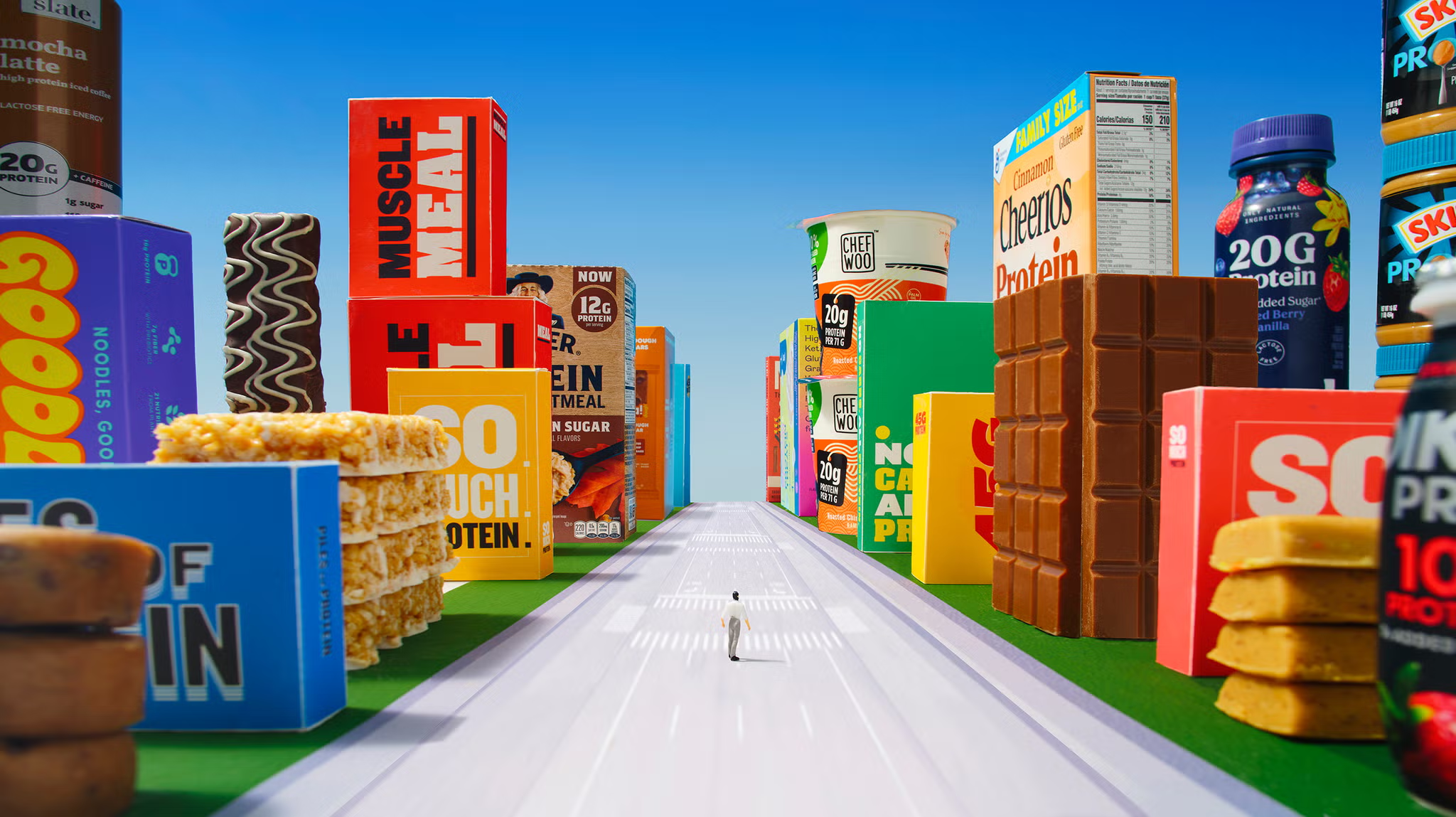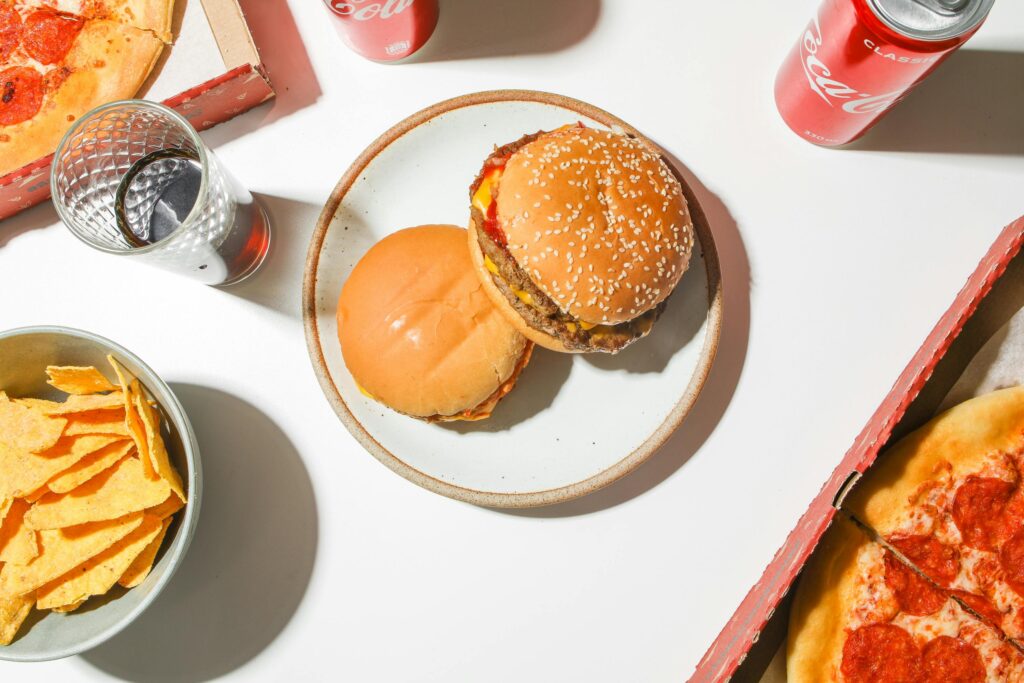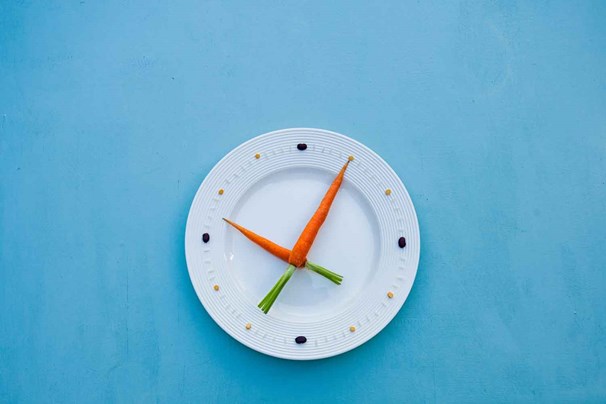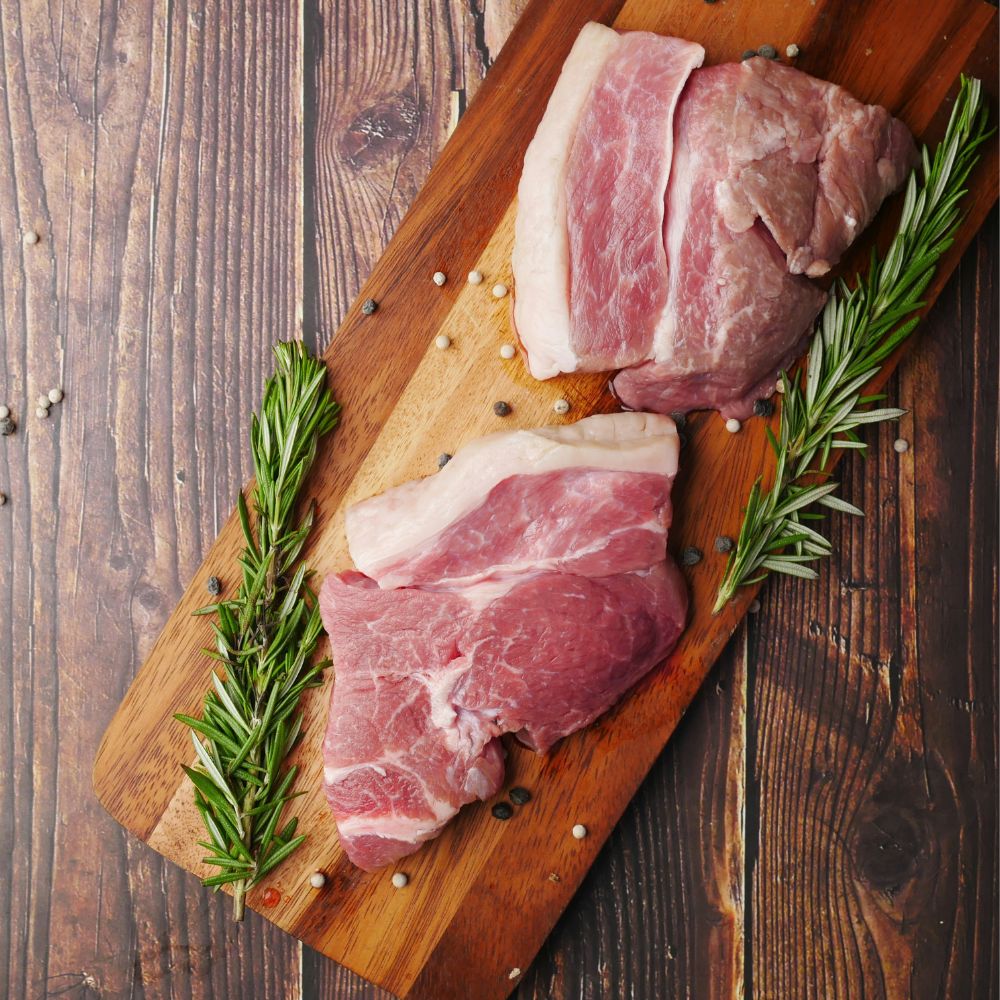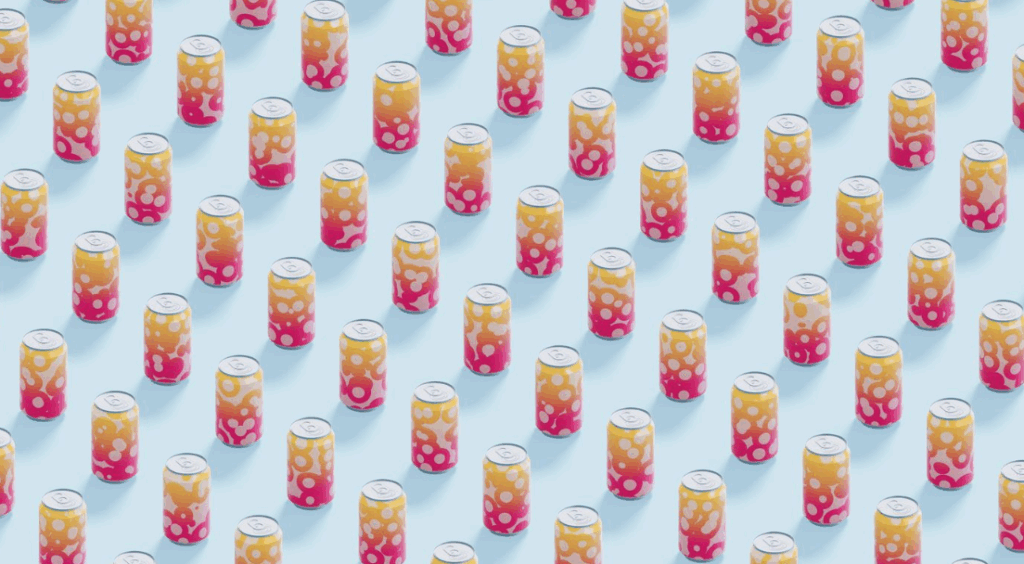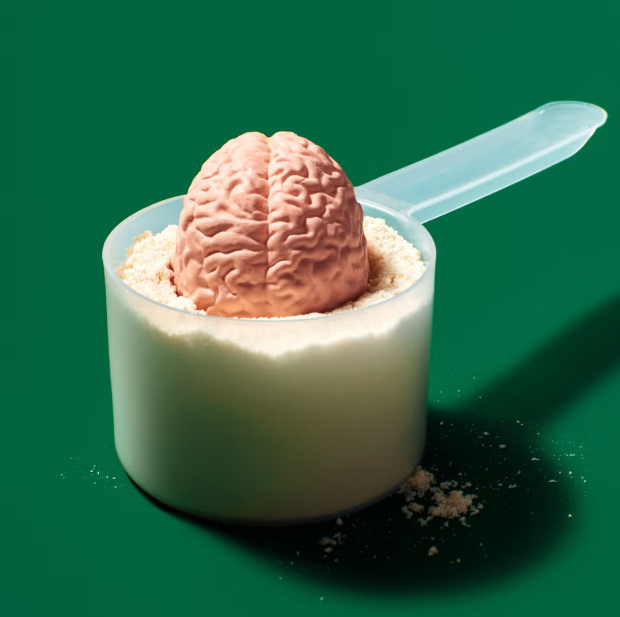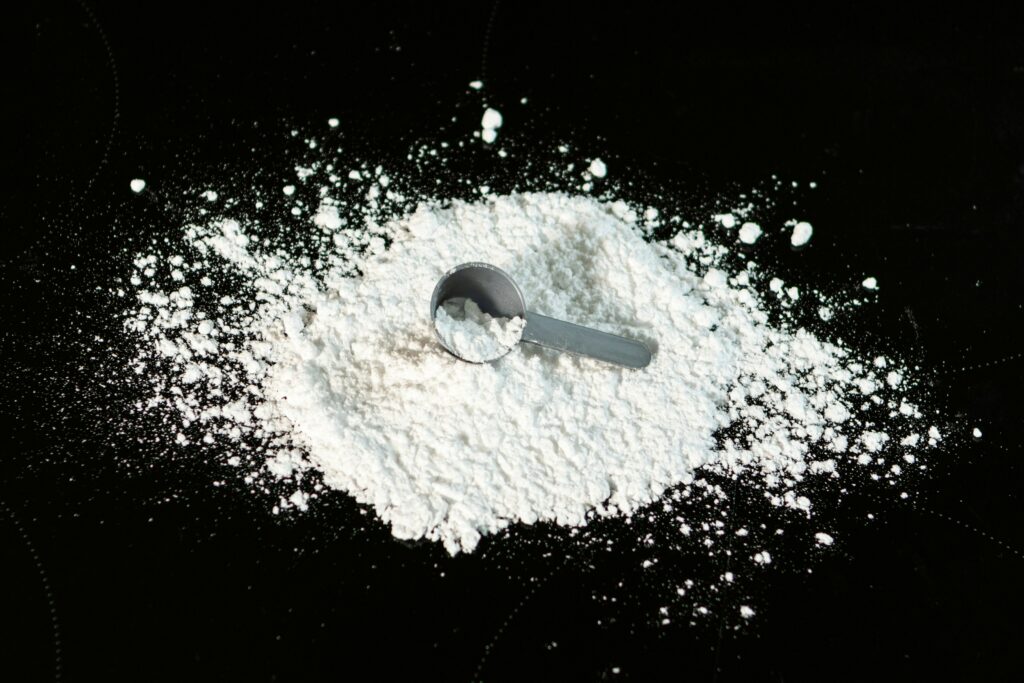IF YOU’VE NEVER experienced the food manufacturing wonder that is a high-protein marshmallow Krispies treat, my god, are you missing out on … something.
The packaging of the treat itself is about what you’d expect: a millennial mashup of crinkly banana-yellow wrapping with splashy fonts promising FUN.
The actual treat inside the package is maybe not what you’d expect: a palm-sized brick of densely packed puffed corn pebbles, the underside shellacked with a sheet of off-white icing, which is also zig-zagged across the top. Oh, maybe this IS going to be fun, you think.
And then you bite into the treat and it is totally not what you’d expect. At first, everything tastes sweet. Your tongue, every square inch of it, top and bottom, tastes sweet. Your cheeks, the roof of your mouth, your teeth. Sweet. Sweet. Sweet. And your brain, firing wildly with delight, signals that you should eat more of these—like, twelve of them.
But then the sweetness fades. As you chew through the krispies, their crunch melting into a gelatinous goo, a chemical tang takes over and a film coats your mouth. Your brain, panicking suddenly with confusion, signals that you should eat no more of these—like, ever.
But, at least you consumed 11 grams of protein that you normally wouldn’t have from a non-protein-ified Rice Krispies Treat, right?
Right now, there’s an entire market of high-protein packaged products out there. Not only high-protein Krispies treats, but cereals, oatmeal, muffins, pastas, yogurts, ice creams, chips, brownies, and even sodas. These products are all banking on three simple facts:
- You know protein is important to your diet.
- You know protein shakes are nasty.
- Given the above, perhaps you’d be interested in a high-protein version of one of your favourite guilty pleasures?
For three weeks, I set out to incorporate as many of these high-protein packaged products into my life as possible. I had two objectives: see if these products could help me build muscle and find out if any of them actually taste good.
WEEK ZERO
The loading phase
First, you have to know that I am not a guy who eats a lot of what people are now calling “ultra-processed” food. I adore Caramel DeLite Girl Scout Cookies, but a package can last me several months. (I savour them!) I love Cool Ranch Doritos, but swear they taste better at the beach, so I only tend to eat them there.
Most of my diet is eggs, oatmeal, fruit, rice, beans, greens, beef, chicken, fish, shrimp, nuts (usually peanut buttered), bites of whatever my kids don’t eat when we dine out, and some beer on weekends. I used to take protein powder. Now I don’t take any supplements. In other words, my diet is boring.

Prior to the experiment, the writer’s typical lunch of rice, hummus, and a ton of vegetables.
High-protein packaged products are very not boring. In bold boxes and bright bottles, these products are Instagram-ready, designed to colour-coordinate seamlessly with the fit-fluencer aesthetic.
I, on the other hand, am an almost-40-year-old dad. But I’m a fit dad who works out seven days a week. At the start of this experiment, I was training for a half-marathon; running 12 to 16 miles a week. I was doing free-weight workouts at home and, once a week, hitting the rowing machine and bench press at the gym.
In all honesty, I was intrigued by these packaged products solely because a high-protein diet had worked for me in the past. Back in my twenties, I packed on 15 pounds of muscle knocking back protein shakes and cramming creatine. The thought of doing that now sounds exhausting (see: kids), but what if I could simplify everything with packaged high-protein products?
So with the help of MH staffer, Charles Thorp, I began to collect as many of these “protein-plus” products as possible.
Over the course of the week, high-protein products filled a large cardboard box in my kitchen. When a shipment of high-protein muffins caused the box to overflow, I knew it was time for the experiment to begin.
WEEK ONE
The shock phase
That marshmallows krispie treat wasn’t the first high-protein product I tasted, but it might as well have been. The vast majority of high-protein packaged products all taste relatively the same: very sweet.
Often, this sweetness comes from things that aren’t sugar: stevia, monk fruit, allulose, sucrolose, and something called “OnoSweet” (as in “oh-no”—because you literally can’t make this shit up). Many of the products have several of these pseudo-sugars in their ingredients lists. This helps keep carbs (the enemy of trendy high-protein diets like Keto) and added sugars (the enemy of all trendy diets, especially Whole30) minimal-to-none.
Some people don’t mind the taste of these sweeteners, but I don’t have anything nice to say to them. (The people or the sweeteners.) Even if the initial blast of SWEET fires the neurons, it gives way to a cloying, saccharine aftertaste that sticks around for too long.
To further complicate taste, many of these high-protein products come in vague and/or confusing flavours: frosted lemonade, tropical punch, and Sundae Funday—a high-protein cookie snack from Quest that involves “chewy toffee, mini chocolatey chips, vanilla flavoured bits, and crumbled peanuts in a delicious vanilla ice cream flavoured base … [with] a white chocolatey coating and rainbow sprinkles over a milk chocolatey drizzle.”
All these flavours assaulted me, and I couldn’t tell you exactly what I was tasting. But maybe that’s the point? “If you can’t dazzle them with taste, baffle them with bullshit flavours,” I believe is how the saying goes.
And speaking of bullshit, boy, was I making a lot of trips to the bathroom during the first week. Although “non-nutritive sweeteners,” as the research calls them, have been deemed safe by governing bodies, some sugar alcohols have been linked to bloating, gas, and diarrhea. (The scientific community is even building research around if they can change your gut microbiota.)
Though my gastro-intestinal distress might also have been due to all the protein. I estimated that I was consuming roughly 150 to 200 grams a day—far more than usual. As we’ve reported on extensively at Men’s Health, increasing the amount of protein in your diet may also increase stomach pain, bloating, and gas.
It doesn’t help that many high-protein products are also high in fibre—especially protein-powered pasta products. A box of Goodles “Ched Over Heels” macaroni and cheese contains roughly 35 grams of protein, yes, but also 16 grams of fibre, which is about as much as 4 ½ apples.
At no point during my first week, short of sleep, was my stomach not twisted in some form of GI pain. These symptoms eased toward the end of the first week, but another drawback surfaced soon after.
A drawback far more depressing.
WEEK TWO
The joy vortex
You hear so much about protein’s muscle-building powers, but not as much about its ability to help you fill up at mealtime (something dietitians call “satiation”) and stay full between meals (“satiety”). Fibre, too, can help with both satisfaction and satiety. Because I was eating so much of both nutrients at meals and for snacks, I had no appetite for my usual side of vegetables or piece of fruit.
I tried to keep all this exciting. I crushed up high-protein chili lime Quest protein chips and used them to form a crust on pan-seared cod. I made homemade pasta salads out of high-protein lupini bean fusilli. I topped my high-protein oatmeal with dried cranberries, sliced banana, and chopped walnuts.
“I was STULTIFIED, SLUGGISH, and kind of DISGUSTED at myself.”
But mainly I just stared into the abyss of the cardboard box in my kitchen, trying to choose which foodstuff I was the least unexcited to consume next.
I don’t want to go scorched-earth on all these products. There were plenty I actually liked. Those Quest chips were tangy like Takis and had a light crisp-crunch. The high-protein pastas I tried were as good as the real thing. An unfortunately named company called Smearcase makes a cottage-cheese-based ice cream that is the best of both those worlds.
But for most of the second week—and throughout the rest of my experiment—“full” doesn’t begin to describe what I was. I was stultified, sluggish, and kind of disgusted at myself. Yogurt drinks, mac n cheese, blueberry muffins—I’m basically eating how my kids eat. And they’re both under the age of 8, I remember thinking. I feel awful.
Low moments, however, can lead us to an important step in the journey that is life: acceptance.
WEEK THREE
The acceptance phase
On day 15, for a snack, I ate a high-protein chocolate chip muffin and drank a high-protein prickly-pear-flavoured water and I didn’t flinch. Twenty minutes later, I didn’t feel like I had to go to the bathroom. Maybe my tastebuds and my guts had adjusted. Or maybe they had relinquished hope.
I also noticed something else had recalibrated internally: I had an increased desire to exercise. With all this protein now sitting around in my system, I felt like I had to use it. I started going to the gym twice a week, a practice I kept up for the rest of the experiment. And I picked up the dumbbells at home more often, on top of my existing weight and cardio workouts.
My tastebuds were deadened, but maybe my muscles would come alive. I would finish the experiment strong—and perhaps stronger.
The results
Before I started this experiment, my measurements were as follows:
155 pounds (70 kg)
Biceps: 12.1″
Chest: 34.5″
Waist: 32″
After three weeks of eating high-protein products at every meal, snack, and indulgence, I did see a change. Although my weight and biceps measurements stayed the same, my chest measurement increased by more than a half-inch. It’s not nothing.
Yet despite the changes to my stature, I was excited to return to my boring whole-food dad diet. Because even if all these high-protein packaged foods can help you build muscle, protein isn’t everything.
A healthful diet includes protein, yes, but also something far more intangible: the true satisfaction of eating real food.
This article originally appeared on Men’s Health UK.
Related:




